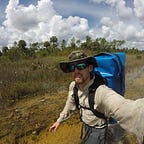Man’s Mark
In Defense of Wilderness
Car troubles and lost cell signals. Both are modern signs of a severed connection from society and both are readily available in the Picayune Strand. For the average American, a flat tire or 3G service is typically accompanied by a brief, or extended moment of panic, but put them together and you have a recipe for a “first world” nightmare. The classic “bum bum bummmmmm” sounds off in our heads and the realization that we now must depend on our own brain and two feet for survival reluctantly settles in. Wild places offer this nightmare to us not to dissuade us from entering, but as a chance to know ourselves as individuals, apart from our gadgets and separate from society.
“People cannot live apart from nature… And yet, people cannot live in nature without changing it. But this is true of all creatures; they depend upon nature, and they change it. What we call nature is, in a sense, the sum of the changes made by all the various creatures and natural forces in their intricate actions and influences upon each other and upon their places…. The making of these differences is the making of the world.” — Wendell Berry
But what happens when our changes go too far?
Wedged between I-75 and Rte. 41 sits the Picayune Strand State Forest; and in the past year, you could often find my coworkers and I driving, hiking or even kayaking deep in the middle of this asphalt sandwich. Starting back in the 1940s, this land underwent a massive change. Vast stands of cypress were logged followed by the construction of roads and canals designed to siphon off its waters and provide access to what was slated to be the largest subdivision in the world. The undertaking left behind a highly altered and damaged ecosystem that would later become the focus of a massive restoration project when development failed. Turns out you can’t completely drain this swamp. Plans now call for us to remove the labyrinth of roads carved into the forest, plug the canals and give it back to the land to paint anyway it sees fit.
Mans mark. From above, it stands out in rather dramatic fashion. The decades of disturbance all melding together into one giant grid of scars. The skeletons of old logging trams and rifts of canals still visible nearly 80 years later are all testaments to the fact that our mark will not soon be erased. Nor will it be forgotten. However, though these lands may be battered and bruised the importance of their presence is never diminished.
“Better a wounded wilderness than none at all.”
- Wallace Stegner
Most people I tell about my work have never even heard of the Picayune Strand and that’s okay. This little known place still plays a crucial role in our lives, even if it’s only in the comfort of simply knowing it exists.
“A man could be a lover and defender of the wilderness without ever in his lifetime leaving the boundaries of asphalt, powerlines, and right-angled surfaces. We need wilderness whether or not we ever set foot in it. We need a refuge even though we may never need to set foot in it. We need the possibility of escape as surely as we need hope” -Edward Abbey
As we’ve worked to monitor the effects of the restoration in the past year I’ve become well acquainted with many of south Florida’s wild places. They’ve humbled me in hardship and instilled in me senses of awe and wonder and beauty. Intricate and connected beyond our wildest dreams, I’ve seen through many hours and photos that we stand to lose much more than just swampland. These are the places that once breathed life into the human spirit and made us who we are today.
“Humans, like all other creatures, must make a difference; otherwise, they cannot live. But unlike other creatures, humans must make a choice as to the kind and scale of the difference they make.” — Wendell Berry
These historically disputed lands are the embodiment of this struggle in south Florida, representing the conflict between where we change nature and to what extent. Where we remove forest and erect towns and where we decide not to develop or in Picayune’s case “undevelop”.
The Strand stands as a prime example of both the best and the worst in us, highlighting our pitfalls as well as our strengths. It’s beginnings may have been deeply rooted in greed, but its creation brought about a heightened awareness and understanding, not just of the role of nature in our region, but of what we stand to lose in its destruction.
The ultimate question in all of this is, “What will our mark be?” Will it be one of development and exploitation or will we find a way to balance our wants with the needs of the planet and hence our own? Though current trends seem to forecast a bleak outlook for the latter, Picayune offers us a tale of hope. Given time it will heal its wounds. Its grasses will break through the roads, trees will reseed the clearings and water will spread once more as a vast sheet, rejuvenating those areas that long ago knew its touch.
May these scars lay present on the ground as in the mind and may the lessons behind them be remembered, as if etched into our very own skin, for generations to come.
At the Conservancy of Southwest Florida we’ve played a big role in monitoring the health of the Picayune Strand for many years, but we also work tirelessly to make sure that wilderness has a voice and a place in the future of all of Southwest Florida.
